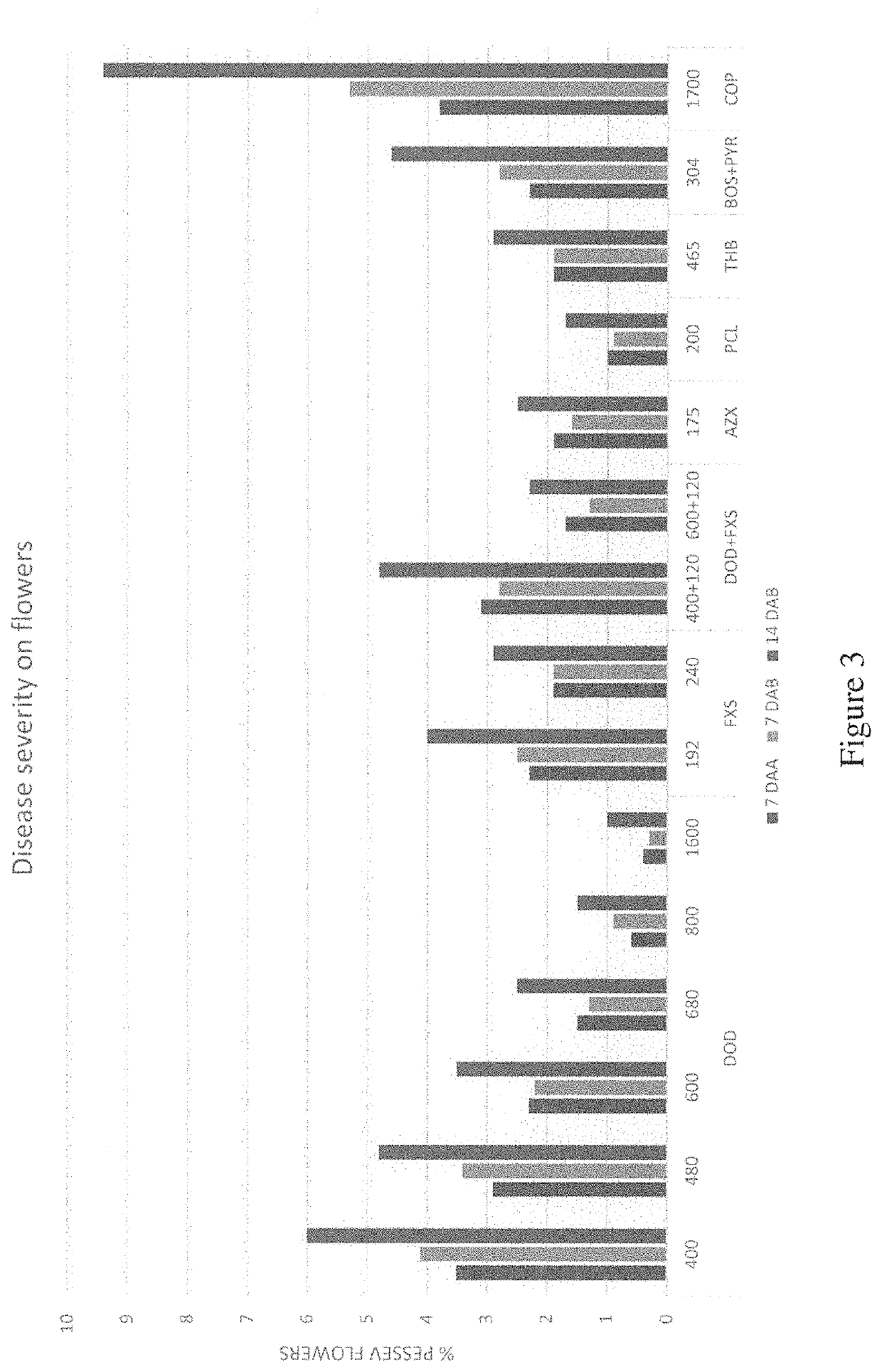Method of controlling anthracnose on tropical fruit plants
a tropical fruit plant and anthracnose technology, applied in the field of control of anthracnose, can solve the problems of increasing costs, reducing appearance and marketability, and affecting the appearance and marketability of anthracnos
- Summary
- Abstract
- Description
- Claims
- Application Information
AI Technical Summary
Benefits of technology
Problems solved by technology
Method used
Image
Examples
example 1
[0102]A trial protocol was conducted on papaya plants using a dodine suspension concentrate (400SC) with a water volume of 578 L / ha. One general copper oxychloride spray (3.5 g / L water) was applied prior to flowering. The trials were conducted at two locations.
[0103]The first foliar spray of dodine was applied at the start of flowering under climatic conditions favorable to the disease (i.e., wet, humid and / or warm weather conditions) and the second foliar spray was applied 7 days later.
[0104]Assessments were taken at 0 days, 7 days after the first foliar spray, 7 days after the second foliar spray and 14 days after the second foliar spray. The plants were assessed for disease increase / severity on flowers to predict yield loss, disease severity on leaves, disease severity on fruits and phytotoxicity according to the scale provided in Table 3.
[0105]
TABLE 3Level of Disease SeverityScaleLevel of AttackSpots per Fruit0NoneHealthy fruit1TracesChlorotic or dark spots, 2LowDark spots, 1-5 ...
example 2
[0109]A trial protocol was conducted on mango plants using a dodine suspension concentrate (400SC) with a water volume of 1060-1100 L / ha. One general copper oxychloride spray (3 kg / ha water) was applied prior to flowering. The trials were conducted at two locations.
[0110]The first foliar spray of dodine was applied at the start of flowering under climatic conditions favorable to the disease (i.e., wet, humid and / or warm weather conditions) and the second foliar spray was applied 7 days later.
[0111]Assessments were taken at 0 days, 7 days after the first foliar spray, 7 days after the second foliar spray and 14 days after the second foliar spray. The plants were assessed for disease increase / severity on flowers to predict yield loss, disease severity on leaves, disease severity on fruits and phytotoxicity according to the scale provided in Table 3.
[0112]The disease incident results on flowers at the first location are shown in FIG. 6, and the disease incident results on fruits at the...
example 3
[0115]A trial protocol was conducted on avocado plants using a dodine suspension concentrate (400SC) with a water volume of 1200 L / ha. The trials were conducted at two locations.
[0116]The first foliar spray of dodine was applied at the start of flowering under climatic conditions favorable to the disease (i.e., wet, humid, and / or warm weather conditions) and the second foliar spray was applied 7 days later.
[0117]Assessments were taken at 0 days, 7 days after the first foliar spray, 7 days after the second foliar spray and 14 days after the second foliar spray. The plants were assessed for disease increase / severity on flowers to predict yield loss, disease severity on leaves, disease severity on fruits and phytotoxicity according to the scale provided in Table 3.
[0118]The disease incident results on leaves at the first location are shown in FIG. 11, and the disease incident results on fruits at the first location are shown in FIG. 12 for each application of fungicide. FIG. 13 shows t...
PUM
 Login to View More
Login to View More Abstract
Description
Claims
Application Information
 Login to View More
Login to View More - R&D
- Intellectual Property
- Life Sciences
- Materials
- Tech Scout
- Unparalleled Data Quality
- Higher Quality Content
- 60% Fewer Hallucinations
Browse by: Latest US Patents, China's latest patents, Technical Efficacy Thesaurus, Application Domain, Technology Topic, Popular Technical Reports.
© 2025 PatSnap. All rights reserved.Legal|Privacy policy|Modern Slavery Act Transparency Statement|Sitemap|About US| Contact US: help@patsnap.com



